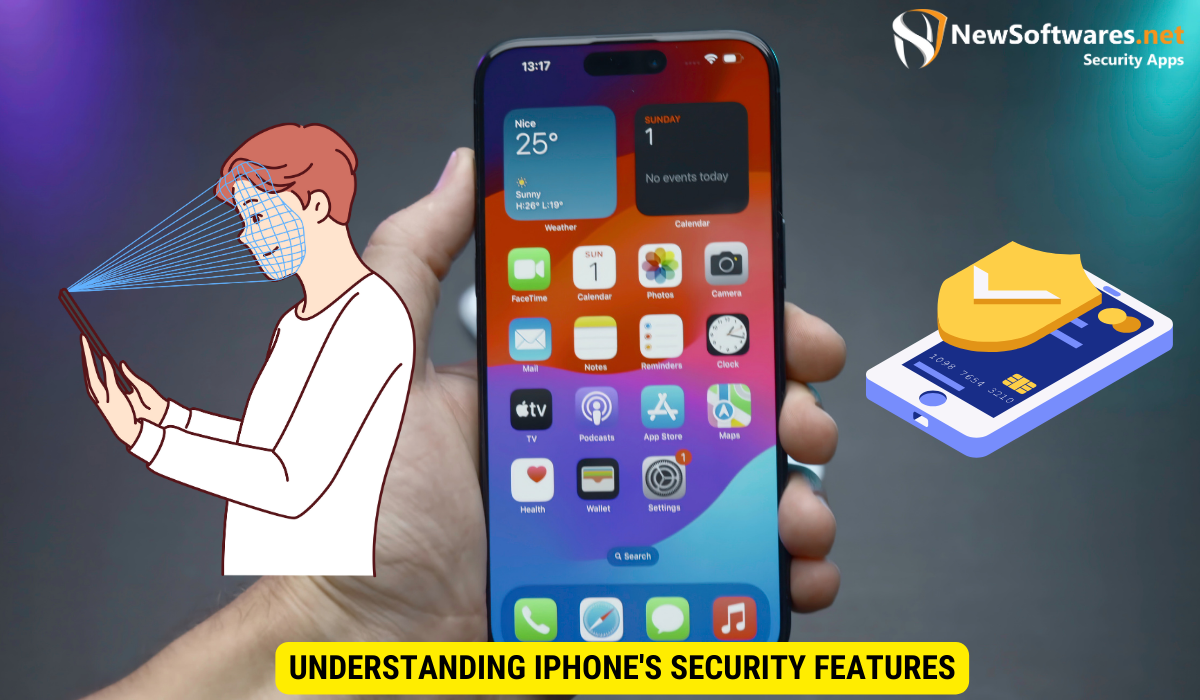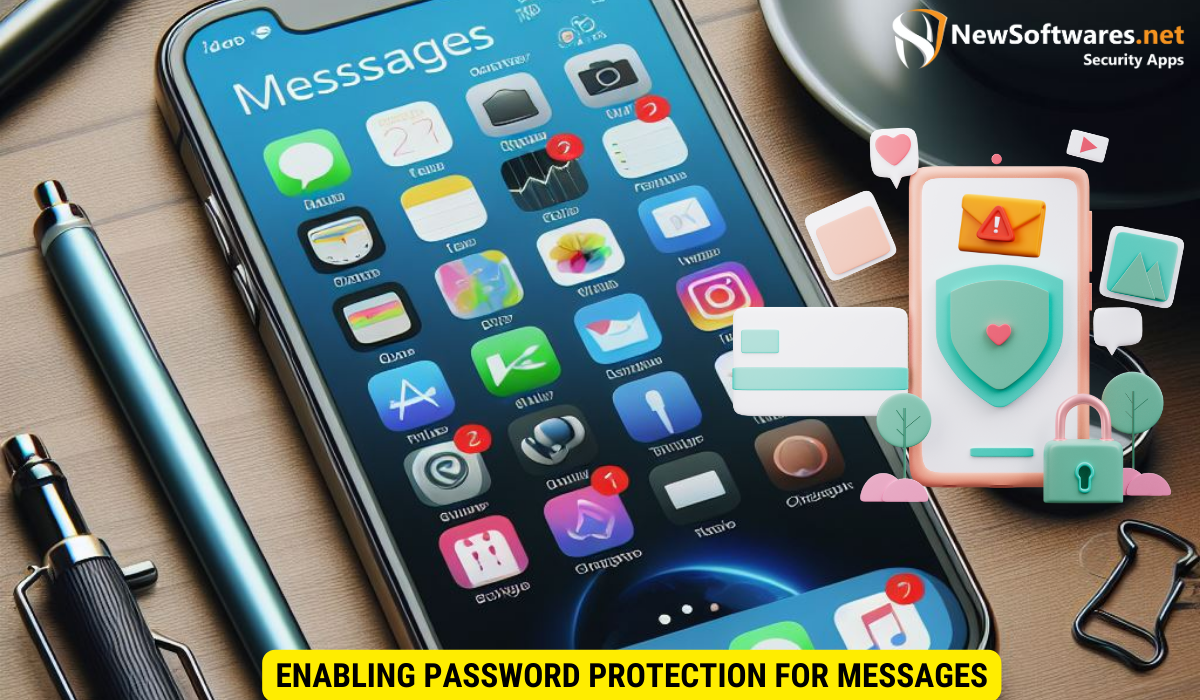To password protect messages on your iPhone, follow these steps:
- Enable Screen Time:
- Go to
Settings>Screen Time.- Tap
Turn On Screen Timeif it’s not already enabled.- Set a Screen Time passcode by tapping
Use Screen Time Passcode.- Set App Limits:
- In Screen Time settings, tap
App Limits>Add Limit.- Select
Social NetworkingorMessagesfrom the list.- Set a time limit (e.g., 1 minute) and tap
Add.- Always Require Passcode:
- Go to
Settings>Screen Time>Always Allowed.- Ensure
Messagesis not in the Always Allowed list.- This will require the Screen Time passcode to access the Messages app after the set time limit is reached.
By using Screen Time limits and a passcode, you can add an extra layer of security to your messages on your iPhone.
In today’s digital age, privacy and security are of utmost importance. With the increasing amount of sensitive information being exchanged through text messages, it’s crucial to take steps to protect your messages from prying eyes. Fortunately, iPhone offers a range of security features to enhance the privacy of your messages. I will guide you through the process of password protecting your messages on iPhone, along with valuable tips for maintaining the security of your messages.
Understanding iPhone’s Security Features

Before we delve into the process of password protecting your messages on iPhone, it’s vital to understand the importance of such security measures. Password protection acts as a safeguard, ensuring that only authorized individuals have access to your messages. By implementing these security features, you can have peace of mind knowing that your personal and confidential conversations remain private.
When it comes to safeguarding your messages, considering the various threats in today’s digital landscape is crucial. Cybercriminals are constantly evolving their techniques to gain unauthorized access to sensitive information. Implementing robust security measures on your iPhone can help mitigate these risks and protect your privacy.
Importance of Password Protection
Password protection serves as a deterrent against unauthorized access. In the event that your iPhone falls into the wrong hands, having a password in place prevents unauthorized individuals from reading or tampering with your messages. It adds an extra layer of security, safeguarding your private conversations from potential breaches.
Moreover, password protection not only secures your messages but also extends to other sensitive data stored on your device. By setting up strong and unique passwords, you create a barrier that shields your personal information from prying eyes, ensuring that your digital identity remains intact.
Overview of iPhone’s Built-in Security Tools
iPhone offers a host of built-in security tools that can significantly enhance the privacy of your messages. These tools include biometric authentication using Face ID or Touch ID, encrypted messaging services, and the ability to password protect individual apps. Understanding these tools will empower you to make informed decisions regarding the security measures you should implement.
Biometric authentication, such as Face ID, adds an extra layer of convenience and security by allowing only authorized users to access the device. Encrypted messaging services ensure that your conversations are protected from eavesdroppers and hackers, maintaining the confidentiality of your communications. With the ability to password protect individual apps, you can further control access to specific information, adding an additional level of security to your device.
Setting Up Password Protection for iPhone
Now that you comprehend the significance of password protection, let’s start by creating a strong password for your iPhone and enable password protection for your messages.
Ensuring the security of your personal data on your iPhone is paramount in today’s digital age. By setting up password protection, you add an extra layer of defense against unauthorized access, safeguarding your messages and sensitive information from prying eyes.
Creating a Strong Password
The first step towards securing your messages is setting up a robust password for your iPhone. A strong password should be unique, unpredictable, and incorporate a combination of letters, numbers, and special characters. Avoid using easily guessable information such as birthdays or addresses.
Consider using a passphrase instead of a single word for added security. A passphrase is a sequence of words or a sentence that is easy for you to remember but difficult for others to guess. This approach can significantly enhance the strength of your password and make it more resilient to hacking attempts.
Enabling Password Protection for Messages

Once you have a strong password in place, it’s time to enable password protection for your messages. Navigate to the Settings app on your iPhone and select “Touch ID & Passcode” or “Face ID & Passcode,” depending on your device’s capabilities. Enter your passcode when prompted. Scroll down to the “Allow Access When Locked” section and toggle the switch next to “Messages” to enable password protection for your messages. Now, whenever you access the Messages app, you’ll be prompted to authenticate using your passcode, Face ID, or Touch ID.
By enabling password protection for your messages, you add an extra level of security to your communication channels. This feature ensures that even if someone gains physical access to your device, they won’t be able to read your messages without proper authentication. Protecting your privacy and confidentiality is essential in today’s interconnected world, and taking these proactive steps can help you safeguard your personal information effectively.
Using Third-Party Apps for Additional Security
While iPhone offers robust built-in security features, some individuals may desire an extra layer of protection for their messages. Fortunately, there is a wide array of third-party apps available that specialize in message security.
Selecting a Reliable Security App
When selecting a third-party security app, it’s crucial to choose a reliable and reputable option. Look for apps that have a proven track record in protecting messages and have received positive reviews from other users. Additionally, ensure that the app offers features that align with your specific security requirements.
Configuring App Settings for Maximum Protection
Upon installing a third-party security app, it’s important to configure its settings to maximize the protection of your messages. This may include setting up additional layers of authentication, enabling encryption for your messages, or customizing alert settings for suspicious activities. Take the time to explore the app’s settings and adjust them according to your preferences.
Maintaining Your Message Security
Securing your messages doesn’t end with enabling password protection and utilizing third-party apps. To ensure ongoing privacy, it’s essential to maintain your message security and adopt a proactive approach.
Regularly Updating Your Password
Periodically changing your iPhone’s password is a simple yet effective way to maintain message security. By regularly updating your password, you reduce the risk of unauthorized access to your device and messages. Aim to change your password every few months and avoid reusing passwords across multiple accounts.
What to Do If You Forget Your Password
Forgetting your iPhone’s password can be a frustrating experience. However, Apple’s security protocols are designed to protect your data in such scenarios. If you forget your password, you can initiate the password recovery process by following the steps outlined on Apple’s support website. Be prepared to provide proof of ownership and follow the instructions carefully to regain access to your device and messages.
Key Takeaways
- Protecting your messages on iPhone is crucial for maintaining your privacy and security.
- Password protection acts as a deterrent against unauthorized access to your messages.
- iPhone offers various built-in security features, including biometric authentication and app password protection.
- Enabling password protection for messages and utilizing third-party security apps provide enhanced security for your messages.
- Maintain your message security by regularly updating your password and following the appropriate password recovery process if necessary.
FAQs
Can I Use Biometrics Instead of a Password?
Yes, iPhone offers biometric authentication options such as Face ID and Touch ID that can be used as an alternative to a traditional passcode. These biometric features provide a convenient and secure way to unlock your device and protect your messages.
How Can I Tell If My Messages Are Secure?
When you enable password protection for your messages on iPhone, you can be confident that your conversations are secure. The prompts for authentication, such as entering your passcode, using Face ID, or Touch ID, ensure that only authorized individuals can access your messages.
What Should I Do If I Forget My iPhone’s Password?
If you forget your iPhone’s password, you can initiate the password recovery process by following the steps outlined on Apple’s support website. Be prepared to provide proof of ownership and follow the instructions carefully to regain access to your device and messages.
Are Third-Party Security Apps Reliable?
Not all third-party security apps are created equal. It’s essential to research and select a reliable and reputable app that has received positive reviews and offers features that align with your specific security requirements. Choose a trusted app and configure its settings for maximum message protection.
How Often Should I Update My iPhone’s Password?
To maintain your message security, it’s recommended to change your iPhone’s password every few months. Avoid reusing passwords across multiple accounts and create strong, unique passwords that are difficult to guess.
Conclusion
In an increasingly connected world, securing your messages on iPhone is vital to protect your privacy. By understanding the significance of password protection, enabling security features, and maintaining good security practices, you can ensure that your conversations remain private and confidential. Take the necessary steps today to safeguard your messages and enjoy greater peace of mind.
